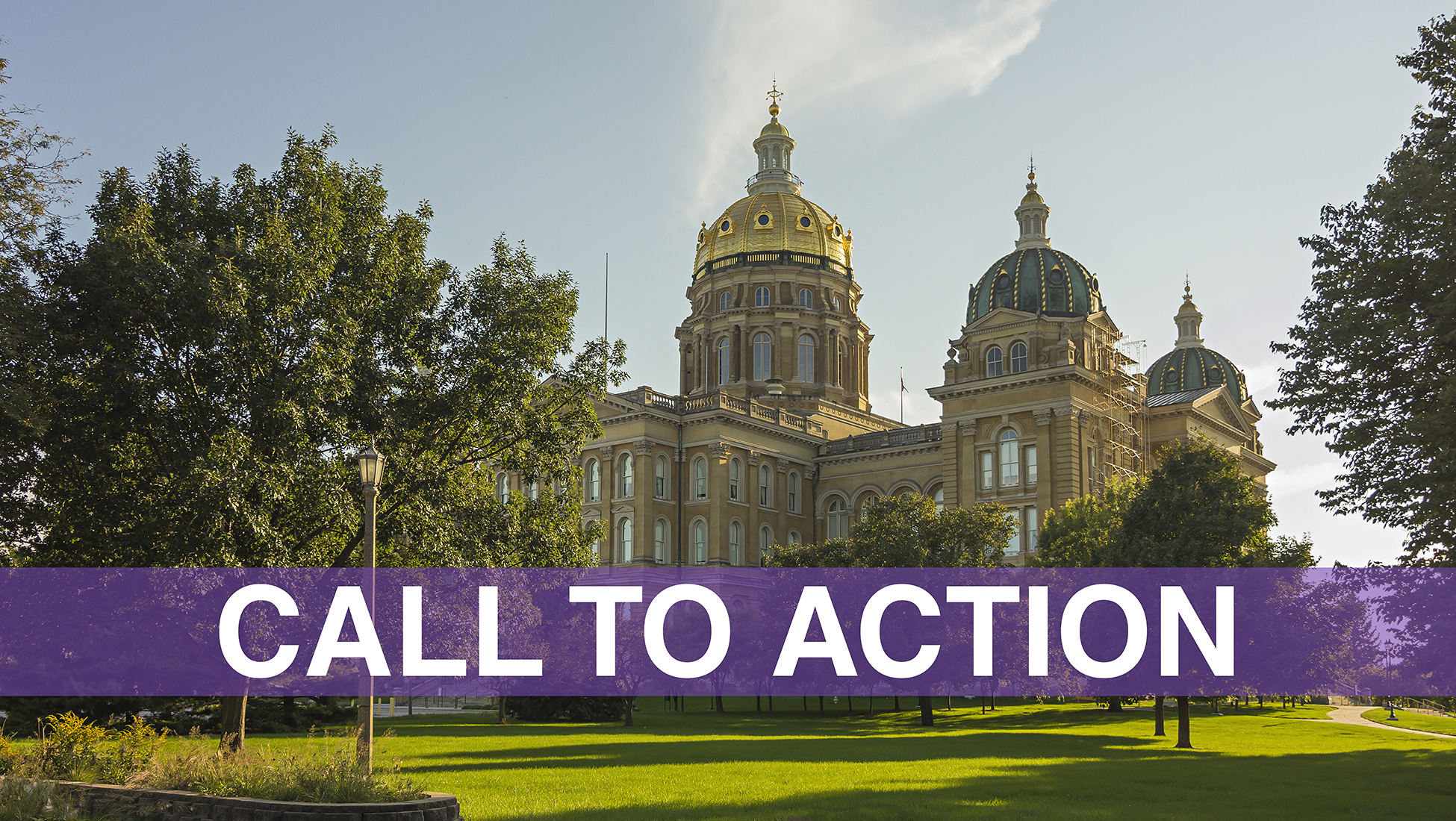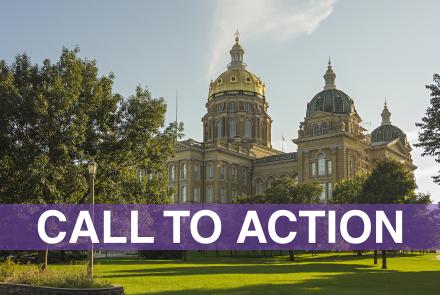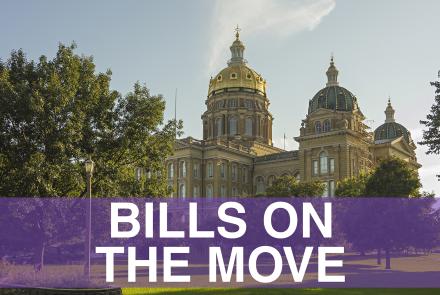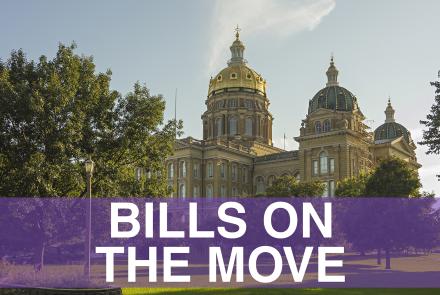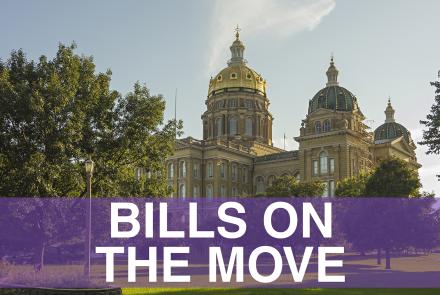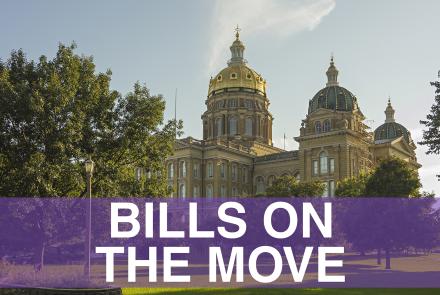Call to Action Update on Governor's School Choice Omnibus Bill
CALL TO ACTION UPDATE
Education Savings Accounts (Vouchers), Charter Schools and
Diversity Plans/Open Enrollment Bills Are Not for Iowa
January 28, 2021
Download the full Call to Action 1/28/2021 document
School Choice Discussions Move in the Senate – Over to the House. Some items of concern were amended out of the bill in the Senate, but our major objections to vouchers, charters and elimination of diversity plans remain. Here’s what you need to know:
SF 159 Governor’s Education Plan. This bill has many provisions that UEN opposes that are not for Iowa. This bill was approved by the Senate Thursday, Jan. 28, 26-21, with Republican Senators Klimesh, Shipley and Sweeney joining the Democrats in opposition and two senators excused (Nunn and Brown). The bill will move over to the House, with its first stop likely in the House Education Committee (membership below).
SF 160: Parent Choice for full-Time: Parent choice for full-time in-person instruction SF 160 was approved in both chambers this evening and passed on to the Governor. One key provision of the amendment was the effective date, which is now stated as the first Monday at least two weeks after the Governor signs the bill. See the UEN weekly report for details of that bill, which we expect the Governor to sign very soon, as early as tomorrow.
When talking about school choice expansion, remember there is already much school choice in urban districts; open enrollment within district, virtual program within district, regulated open enrollment out of the district, good nonpublic schools (with significant tuition assistance for low-income families provided by school tuition organizations), competent private instruction (home school with support) or independent private instruction (home school without support.) The additional benefit of one more choice for a few parents has larger negative consequences for students who remain in the school, for taxpayers and for the rest of the community.
Vouchers: SF 159 includes “Student First Scholarships” called education savings accounts for resident students in schools in need of comprehensive support and improvement. There are 34 schools are on the ESSA list, 17 urban and 17 rural. The urban districts on the ESSA list have an average of 76% poverty, ELL average of 18% (Marshalltown and Des Moines combined have an average of 80% low-income and 34% ELL students in their schools on the list.)
Here are some talking points to use regarding vouchers:
- Use public dollars for public schools. Period. The public’s investment should be used to support public community schools which are open to all students regardless of race, religion, gender, socio-economic status and disability, not for a new entitlement program for parents who choose private education.
- Public funds require public accountability and transparency. Public schools are overseen by a publicly elected citizen governing board, are required to report academic results to the general public, have an annual public financial audit, and be transparent with all expenditures and decision-making. Private and religious schools are not held to that same public transparent standard for either financial or student achievement accountability. Taxpayers have a right to know how their funds are being used, but are left in the dark about the use and impact of voucher funds. There is no evidence that vouchers for low-income, ELL or special education students from schools on the ESSA list will improve outcomes for students, especially considering that admissions policies of private schools are not required to change to accept the voucher.
- A slippery slope toward a costly and expansive voucher program: This voucher program may start small, but as we've seen in other states, once a program is established, it is easy to expand. This will pull more resources away from public schools.
- Reduced Resources for Public School: The fiscal note shows an estimated reduction of $3.8 million for the “scholarships”. There’s a $46 million decrease in state revenues due to tax credit expansion. Essentially 43% of state general funds go to public schools. 43% of that revenue reduction is $19.8 million less for public schools. There is no estimate on the pull of public school resource away for charter schools. Instead of moving money around on the plate, the legislature would do well by the low-income minority students they seek to support by funding high-needs schools grants, increasing ELL weighting in the formula, and creating a poverty factor in the Iowa school foundation formula.
- Vouchers don’t deliver improved student learning: Recent Federal Department of Education review of the DC Voucher plan after three years showed no improvement of learning for any subgroup. Funding the $10 million in High Needs schools grants originally included in Bi-partisan Education Reform Legislation in 2013 would be a good start. Considering a poverty factor in the funding formula for districts with concentrated poverty would also improve results.
Voluntary Diversity Plan Restrictions (Division III in SF 159 and HF 228)
The goals of voluntary diversity plans are to preserve a mix of diversity and prevent segregation of schools in these five districts (Davenport, Des Moines, Postville, Waterloo, and West Liberty.) These bills would eliminate the ability of five school boards to regulate open enrollment out of their districts based on their diversity plan. See the UEN Issue Brief explaining the issue and showing data on poverty, minority, open enrollment and certified enrollment for these and similar districts without voluntary diversity plans. UEN opposes this bill in the House and Division III of SF 159 and HF 228, which was approved by the House Education Committee on party lines and is now on the House Calendar.
Here are some talking points to use regarding diversity plans:
- Low income and minority students are already allowed to open enroll out and the sending school pays for transportation. More than 2,000 students open enroll out of these 5 districts.
- Solid research shows a concentration of poverty hits a tipping point at 50-60%, increasing the costs and challenge of educating every student in the system to success. Classrooms with diversity of socio-economic backgrounds do better for students. Likewise, segregated schools with concentrated minority populations, almost always accompanied by concentrated poverty, negatively impacts student achievement, economic growth and workforce diversity for such communities. https://www.legis.iowa.gov/committees/committee?ga=89&groupID=686
- Voluntary diversity plans have served districts with large minority populations well, perhaps staving off ugly court challenges that could order district desegregation efforts. Without this practice, the concentration of poverty and minority would increase among those remaining in the district and court challenges become more likely.
- Higher concentrations of poverty and minority elevate the cost of education and the challenges of success and opportunities for students. The health of the inner city becomes the economic development driver of the broader community in the wrong direction. The Washington Center for Equitable Growth has this piece on the impact of segregation on economic growth: https://equitablegrowth.org/school-segregation-undermines-u-s-economic-mobility-and-dynamism/
- Suburban districts already struggle with hefty property tax bonds to keep up with residential enrollment growth. This additional enrollment would add to suburban property tax challenges.
Charter Schools, SF 159, would allow two kinds of charter schools; charter school with school boards initiating the charter further approved by the State Board of Education, or charter schools founded by private entities if approved by the State Board of Education, without local board approval or support. UEN is opposed to this provision.
Talking points on Charter Schools:
- The intended purpose of this legislation sounds exactly like what public schools would like to be able to do: innovative instruction, freedom from regulation, better methods of measuring student achievement, innovative budget practices, staff ownership and responsibility, etc. With almost 30 years of charter school history in our country with mixed results, shouldn’t public schools be able adopt those practices that have worked without sacrificing the local control of school boards and risking the closure and disruption of failed charter schools without accountability?
- Rural school district economies of scale would be at further risk if charter schools drain students, resulting in less opportunity and course choices for those remaining in the public school.
- Urban center politics, responding to tight budgets or changes in attendance center boundaries to balance socio-economic status, or closing an attendance center for efficiency (to live within the budget) create motivational entries for some impacted parents and staff into charter school status. This is the opposite of local control and good stewardship of our tax dollars provided by locally elected school board members.
- Opening or closing a charter school is added to the list of items for which a school district can request spending authority from the SBRC. The Fiscal Note also mentions that student enrollment would be counted twice in the year in which a charter school opens. These two provisions could increase local property taxes.
Open Enrollment Changes: The provision of SF 159 creating a separate open enrollment deadline for students open enrolling out of an ESSA identified school was amended out of the bill during the Senate floor debate. The bill adds to the good cause exceptions to the open enrollment deadline the inability of the resident district to adequately address a consistent failure to reasonably respond to a student’s failure to meet basic academic standards after notice provided by a parent or guardian, with criteria to be determined by the state Board of Education. The bill, as amended, removes the 90-day waiting period for students to participate in extracurricular activities only due to a good cause open enrollment or due to a school board action to eliminate the activity in which they wanted to participate. The amendment requires that athletic ineligibility in one district will apply to the student in a district to which they open enroll. The amendment in the Senate removed the ability of buses to go into neighboring districts to pick up students and take them to their open enrolled school without the resident district’s consent. The bill increases the eligibility of students to have transportation to the receiving districts up to 200% of the federal poverty level. UEN has no major objections to this provision as amended.
Expansion of Tuition and Textbook Tax Credits: the bill adds home school expense to the tax code eligibility for the tuition and textbook tax credit, increases the amount of allowed expenses from $1,000 to $2,000; doubles the credit to 50% of eligible expenses, and makes the credit refundable. These provisions primarily benefit home school and private school parents who spend more on allowable expenses than public school parents. This provision is estimated to cost the state general fund $46 million in lost revenue. If apportioned to PK-12 schools, 43% of that is a loss of $19 million.
Talking points on Expansion of Tuition and Textbook Tax Credits:
- Currently, this tax credit costs the state $15.1 million. This is a significant expansion.
- Expansion of STO’s (scholarships for private school) and allowing private school expenditures to be pretax through 529 plans already creates tax advantages for private school parents. Making this credit refundable expands that benefit further.
- The state already provides over $65 million to support private school families and students.
Enrollment Count Date for Budgeting: the bill originally created an April 1 first enrollment count, but the amendment strikes that provision and instead sets up a School District Enrollment Study Group, including a representative from the UEN and a representative of a district appointed by the UEN among its membership. The group is to study on-time funding, budget guarantee, and which funds should follow student open enrollment to a receiving district. UEN supports this provision.
Flexible Student and School Support Program: this provision allows school districts flexibility in adopting innovative programs, such as those focused on STEM, STEAM and work-based learning experiences. Also allows excess TSS and TCL balances to be transferred to the flexibility account and allows the flexibility account to pay for the program. UEN supports this provision, which includes freedom from certain state mandates, rewards innovative approaches and provides funding flexibility.
House Education and Ways and Means Committee Members
|
To call and leave a message at the statehouse during Session, the House switchboard operator number is 515.281.3221 and the Senate switchboard operator number is 515.281.3371. You can ask if they are available, leave a message for them to call you back, or leave a short message to “oppose SF 159 Governor’s School Choice bill.” Legislators are typically back home over the weekend. |
The following links will take you to each committee member’s legislative page, with email address and often home or cell phone number so you can easily connect with them. Remember to be respectful and explain the impact these bills would have on your school and education for your students. Also, be sensitive to using school email when contacting legislators who may prefer you use your personal email rather than school property for advocacy purposes.
House Education Members (Oppose SF 159)
|
House Ways and Means Members (Oppose SF 159)
|


